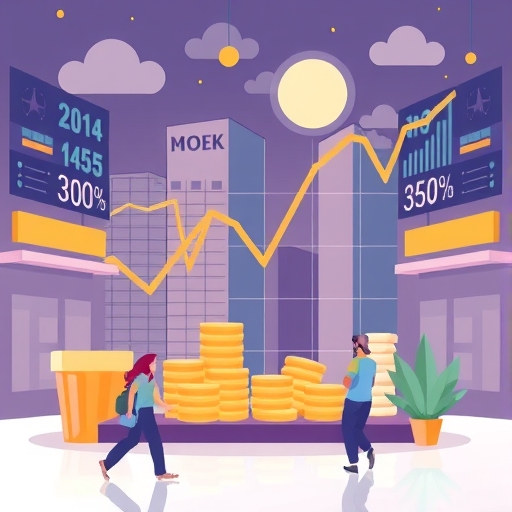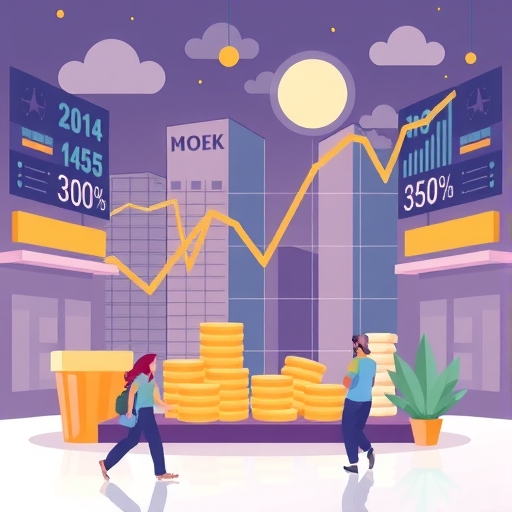Understanding Leveraged Stocks: Amplifying Your Market Potential (and Risks)
Are you curious about how some traders can control large positions in the stock market with relatively small amounts of capital? This powerful strategy, known as leveraged trading, opens up significant opportunities but also comes with substantial risks. In this comprehensive guide, we’ll explore the world of leveraged stocks and Contracts for Difference (CFDs), demystifying how they work, the compelling benefits they offer, and the critical dangers you must understand. We aim to equip you with the knowledge to navigate this high-stakes arena, ensuring you make informed decisions about whether this approach aligns with your financial goals and risk tolerance. 
The Mechanics of Leverage: CFDs, Margin, and Amplified Trading Power
At its core, leverage in financial markets means using borrowed capital, often from a broker, to increase the size of your trading position beyond what your initial investment alone would allow. Think of it like using a small amount of your own money as a down payment to control a much larger asset. This amplification is particularly common in CFD trading, where you speculate on the price movement of an underlying asset without actually owning it. Instead, you enter a contract with your broker to exchange the difference in the asset’s price from when you open the trade to when you close it.
Leverage provides several key advantages for traders looking to maximize their market exposure. These benefits include:
- **Increased Capital Control:** With a smaller initial investment, you can control a significantly larger position in the market.
- **Access to Expensive Assets:** Leverage makes it possible to trade high-priced stocks or assets that would otherwise be out of reach for your capital.
- **Enhanced Diversification:** You can spread your capital across a wider range of assets and markets (stocks, forex, indices, crypto) simultaneously.
- **Potential for Higher Returns:** Even small price movements can translate into substantial profits due to the magnified position size.
How does this amplification work? It’s all about margin. When you engage in leveraged trading, you’re required to put down an initial deposit, called the deposit margin. This margin acts as a form of collateral. Your broker then lends you the rest of the funds needed to open a larger position. Leverage is often expressed as a ratio, such as 1:5, 1:10, or even 1:500. For instance, with a 1:10 leverage ratio, for every $1 of your own capital, you can control $10 worth of the asset. If you invest $100 with 1:3 leverage, you effectively control a $300 position, and your profits or losses will be calculated on that full $300, not just your initial $100. This capacity to access more funds allows you to increase your position size and potentially trade a wider variety of stocks simultaneously, including more expensive securities that might otherwise be out of reach. It also offers opportunities for portfolio diversification across various markets like stocks, indices, forex (foreign exchange), and even cryptocurrencies. 
To better understand how different leverage ratios impact your trading capacity, consider the following examples:
| Initial Capital | Leverage Ratio | Effective Position Size | Example: Price Change of 1% | Resulting Profit/Loss |
|---|---|---|---|---|
| $1,000 | 1:1 (No Leverage) | $1,000 | $10 | $10 (1% of capital) |
| $1,000 | 1:10 | $10,000 | $100 | $100 (10% of capital) |
| $1,000 | 1:50 | $50,000 | $500 | $500 (50% of capital) |
| $1,000 | 1:100 | $100,000 | $1,000 | $1,000 (100% of capital) |
Navigating the Double-Edged Sword: Risks, Rewards, and Investor Psychology
Before engaging in leveraged trading, it is vital to be aware of the significant risks involved, which include:
- **Magnified Losses:** Just as profits are amplified, so are losses, potentially leading to rapid depletion of your capital.
- **Margin Calls:** If your position moves unfavorably, you may be required to deposit additional funds to avoid forced liquidation.
- **Volatility Drag:** Leveraged ETFs, in particular, can suffer performance decay over time, making them unsuitable for long-term holding.
- **Overleveraging:** The temptation to take on excessive risk can lead to substantial and irreversible damage to your trading account.
While the allure of amplified profits with leveraged stocks is undeniable, it’s crucial to understand that leverage is a double-edged sword. Just as it magnifies potential gains, it equally magnifies potential losses. Many retail investor accounts lose money trading CFDs, with statistics often showing rates between 74% and 87.41% experiencing losses. This stark reality underscores the significant risks involved.
One of the most immediate dangers is the margin call. If your leveraged position moves against you and your losses erode your initial margin, your broker may issue a margin call, demanding you deposit additional funds to maintain your position. Failure to meet a margin call can result in your broker automatically closing your position to prevent further losses, often realizing substantial losses for you. Another critical risk, particularly with Leveraged ETFs (Exchange Traded Funds), is volatility drag. These ETFs typically rebalance daily, meaning their performance can decay over longer periods, especially in volatile markets, making them generally unsuitable for long-term holding. Furthermore, overleveraging, often driven by emotional trading, can quickly lead to irreparable damage to your trading account. It’s a common pitfall for inexperienced traders who might be tempted to take on excessive risk in pursuit of quick returns. 
Understanding how rapidly losses can accumulate with leverage is paramount. Consider this simplified example of a leveraged trade moving against you:
| Initial Capital | Leverage Ratio | Effective Position Size | Market Moves Against You | Loss on Position | Loss as % of Initial Capital |
|---|---|---|---|---|---|
| $1,000 | 1:10 | $10,000 | 1% | $100 | 10% |
| $1,000 | 1:10 | $10,000 | 5% | $500 | 50% |
| $1,000 | 1:10 | $10,000 | 10% | $1,000 | 100% (Capital Wiped Out) |
So, why do investors still engage in leveraged trading? The potential rewards can be significant. By using leverage, you gain access to more funds, allowing for larger position sizes and the ability to capitalize on smaller price movements. This can lead to skyrocketed profits in favorable market conditions. You can also diversify your portfolio by trading various asset classes like stocks, indices, and commodities, which might otherwise require a much larger capital outlay. However, investor communities like those on Reddit and Quora often discuss the nuanced view that while leveraged products offer substantial risk-weighted returns in specific bull markets, their inherent dangers, especially for long-term holding due to compounding effects and volatility, must be carefully considered. Therefore, disciplined risk management and a clear understanding of your personal risk tolerance are paramount to navigating these markets successfully.
To illustrate the potential for amplified returns, consider a scenario where a stock you invest in increases in value. The difference between a non-leveraged and a leveraged trade can be substantial:
| Scenario | Initial Capital | Leverage Ratio | Position Size | Stock Price Increase | Gross Profit | Return on Initial Capital |
|---|---|---|---|---|---|---|
| Non-Leveraged | $1,000 | 1:1 | $1,000 | 5% | $50 | 5% |
| Leveraged | $1,000 | 1:10 | $10,000 | 5% | $500 | 50% |
Choosing Your Arsenal: Brokers, Platforms, and Global Market Access
When selecting a broker for leveraged trading, several crucial factors should guide your decision to ensure a secure and effective trading experience:
- **Regulatory Compliance:** Prioritize brokers regulated by top-tier financial authorities to ensure investor protection and fair practices.
- **Platform Quality:** Look for user-friendly and feature-rich trading platforms, including advanced charting and analytical tools.
- **Asset Range:** Ensure the broker offers access to the specific stocks, indices, commodities, or currencies you intend to trade.
- **Leverage Limits:** Understand the maximum leverage offered and ensure it aligns with your risk management strategy and local regulations.
- **Fee Structure Transparency:** Carefully review all trading and non-trading fees, including spreads, commissions, overnight fees, and withdrawal charges.
Selecting the right online broker and trading platform is a critical step in your journey into leveraged stock trading. The first and most important factor is broker regulation. Always choose a broker regulated by reputable authorities such as the Financial Conduct Authority (FCA) in the UK, the Australian Securities and Investments Commission (ASIC), or the Cyprus Securities and Exchange Commission (CySEC). These regulatory bodies provide investor protection and often impose limits on the maximum leverage offered, which can vary significantly by jurisdiction (e.g., 1:5 for stocks in the UK/EU compared to potentially higher ratios elsewhere).
Once you’ve confirmed a broker’s regulatory standing, consider their offerings. What kind of trading platforms do they provide? Many popular brokers like eToro, Capital.com, XTB, AvaTrade, and Pepperstone offer their own proprietary platforms, which are often user-friendly and feature-rich. They might also support industry-standard platforms like MetaTrader 4 (MT4), MetaTrader 5 (MT5), or cTrader, known for their advanced charting tools and algorithmic trading capabilities. These platforms are typically available across desktop and mobile devices, allowing you to manage your positions on the go. When creating your brokerage account, you’ll also want to review the available funding methods (e.g., Skrill, Visa, PayPal, Wire Transfer) and ensure they are convenient for you.
Furthermore, consider the range of stocks and other assets the broker allows you to trade with leverage. A good broker provides access to major global stock exchanges such as the New York Stock Exchange (NYSE), NASDAQ, London Stock Exchange (LSE), and Frankfurt Stock Exchange, alongside various other international markets. This broad access allows for greater diversification and the ability to capitalize on opportunities across different regions and industries. Look for clear information on their maximum leverage limits, available account types (e.g., demo, retail, professional), and any specific features that align with your trading style, such as social trading capabilities or advanced analytical tools. 
The Cost of Amplification: Understanding Fees and Commissions in Leveraged Trading
Engaging in leveraged trading isn’t free; there are various costs that can impact your overall profitability. Understanding these fees is crucial for accurately assessing your potential returns and avoiding unexpected drains on your capital. These costs generally fall into two categories: trading fees and non-trading fees.
Trading fees are directly related to opening and closing your positions. The most common trading fee is the spread, which is the difference between the bid (buy) price and the ask (sell) price of an asset. The tighter the spread, the lower the cost to enter and exit a trade. While many brokers advertise “zero commission” on stock CFDs, this typically means the cost is built into the spread. For other assets like forex or specific types of leveraged products, you might encounter explicit commissions, which are a direct charge per trade or per volume traded.
Beyond the immediate act of trading, several non-trading fees can accumulate, especially for leveraged positions held overnight or longer. These include:
- Overnight Fees (Swap Fees): Since you’re using borrowed capital, brokers charge interest for holding leveraged positions open overnight. This fee can be positive or negative depending on the asset and interest rate differentials.
- Weekend Fees: Often, brokers charge a triple overnight fee for positions held over the weekend to account for the three days.
- Withdrawal Fees: Some brokers charge a fee when you transfer funds out of your trading account.
- Currency Conversion Fees: If your trading account is in a different currency than the asset you’re trading, you might incur a fee for currency exchange.
- Inactivity Fees: If your account remains dormant for an extended period without any trading activity, some brokers may charge a monthly inactivity fee.
These fees, particularly overnight and weekend fees, can significantly impact your net profits, especially for long-term leveraged positions. Always review a broker’s full fee schedule before opening an account to ensure you understand all potential costs.
Strategic Considerations and Advanced Leveraged Instruments
Beyond the foundational understanding of leverage, successful trading involves strategic thinking and an awareness of more advanced instruments. When considering which stocks to trade with leverage, it’s wise to examine factors like historical stock performance, understanding that past results are not guarantees of future profits. Analyzing shareholder patterns can also reveal insights into a company’s financial health and ownership structure. Furthermore, recognizing the inherent volatility of a particular market or stock is crucial, as higher volatility generally translates to higher risk in leveraged positions.
For those looking to explore more sophisticated strategies, leverage extends beyond simple long or short positions on individual stocks. For example, some traders employ long-short strategies using futures contracts, aiming for market neutrality by balancing long positions in one index (like the S&P 500) with short positions in another (like the Russell 2000). In the cryptocurrency space, instruments like perpetual futures allow for highly leveraged speculation on assets like Bitcoin and Ethereum without expiry dates. These strategies require precise beta-weighting and meticulous accounting for transaction costs to be effective.
However, it’s vital to reiterate that these advanced applications of leverage carry even greater complexity and risk. Continuous learning, a deep understanding of personal finance, and disciplined execution are essential. We strongly advise against excessive “day trading” for inexperienced individuals, as it can quickly devolve into gambling if not approached with a well-defined strategy and stringent risk management protocols. Always remember that the goal is not just to make profits, but to preserve capital and grow your wealth sustainably, which means being acutely aware of the dangers that amplified market exposure can introduce.
Leveraged stock trading, particularly through CFDs, offers a compelling path to potentially higher returns by expanding your market reach. However, it demands a profound understanding of its intricate mechanisms and significant risks. While instruments like CFDs and leveraged ETFs can amplify gains, they equally magnify losses, necessitating rigorous risk management and careful broker selection. By understanding the underlying principles, costs, and investor sentiment, traders can approach leveraged markets with greater awareness, ensuring decisions are informed, strategic, and aligned with their individual risk tolerance.
Disclaimer: This article is for informational and educational purposes only and should not be considered as financial advice. Leveraged trading and CFDs carry a high level of risk and may not be suitable for all investors. You could lose more than your initial deposit. It is essential to fully understand the risks involved and seek independent financial advice if you have any doubts.
Frequently Asked Questions (FAQ)
Q: What is leveraged trading?
A: Leveraged trading involves using borrowed capital from a broker to increase the size of your trading position beyond what your initial investment alone would allow. It amplifies both potential gains and losses.
Q: What are CFDs, and how do they relate to leveraged stocks?
A: CFDs (Contracts for Difference) are a popular way to trade leveraged stocks. With a CFD, you speculate on the price movement of an underlying stock without actually owning the shares. You enter a contract with your broker to exchange the difference in the asset’s price between opening and closing the trade.
Q: What are the main risks of trading leveraged stocks?
A: The primary risks include magnified losses, the possibility of margin calls requiring additional capital, volatility drag in instruments like Leveraged ETFs, and the danger of overleveraging, which can quickly deplete your trading account. Due diligence and strict risk management are essential.



No responses yet